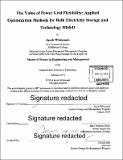| dc.contributor.advisor | Mort Webster. | en_US |
| dc.contributor.author | Whitcomb, Jacob A | en_US |
| dc.contributor.other | System Design and Management Program. | en_US |
| dc.date.accessioned | 2016-11-14T19:05:53Z | |
| dc.date.available | 2016-11-14T19:05:53Z | |
| dc.date.copyright | 2014 | en_US |
| dc.date.issued | 2014 | en_US |
| dc.identifier.uri | http://hdl.handle.net/1721.1/105303 | |
| dc.description | Thesis: S.M. in Engineering and Management, Massachusetts Institute of Technology, Engineering Systems Division, 2014. | en_US |
| dc.description | Cataloged from PDF version of thesis. | en_US |
| dc.description | Includes bibliographical references (pages 104-110). | en_US |
| dc.description.abstract | As power systems adapt to include aging infrastructure, new socio-political priorities, and renewable electricity resources, grid operators look to a more flexible grid. Electricity storage flexibility is one strategy gaining interest. Clean energy advocates see benefits in terms of greater renewables integration and lower emissions; grid operators see storage as an improved security system in the face of supply and demand variability and uncertainty. However, as power systems are designed for reliable and efficient operations using available technologies, newer, better-performing technologies such as energy storage devices may not always win the market. Several market barriers to storage remain, including high storage capital costs and a lack of trusted tools for modeling and estimating the lifetime value of new capacity investments [1]. Most storage modeling strategies omit constraints that describe the technical operating boundaries of different power generating technologies, which can lead an overestimation of total operating costs for the power system [2]. I describe a mixed integer linear optimization framework for estimating the optimal control and value of energy storage in a virtual power generation system with economic, regulatory, and technical performance characteristics. The model consists of power plant commitment, dispatch, and selective capacity expansion constraints that simulate optimal investments and operations of the power generation system. A new formulation for modeling energy storage is also developed in order to improve the accuracy of round-trip efficiencies and allow for the inclusion of minimum storage output constraints. Using this model, I solve for break-even target prices for storage capital costs under a range of scenarios (storage futures scenarios). A second challenge slowing the adoption of storage is a lack of spending on performance improvements and cost-reductions. A two-factor learning curve and optimization approach is developed to solve for the optimal portfolio of research, development, demonstration, and diffusion investments (RDD&D) over multiple investment periods. Using the target capital costs from unit commitment model output as the investment model input value, innovating firms and policy planners may better identify cost targets and investment strategies for reaching target levels of storage deployment. Electricity storage becomes more valuable as net load variability increases. The impact of net load variability is tested by changing the level of renewable generation resources in the system. The current capital cost of storage-here, compressed air energy storage (CAES)-generally exceeds the target cost needed to make CAES economical when it is used to provide load following, load shifting, and operating reserve services in high-voltage power generation systems. Scenario analysis shows that when renewables generation reaches 35%, CAES becomes economical in limited quantities due to the added value from providing renewables integration and greater operating reserves. Using this framework, I identify different levels of cost reductions needed to drive improved adoption and make several RDD&D recommendations. | en_US |
| dc.description.statementofresponsibility | by Jacob Whitcomb. | en_US |
| dc.format.extent | 110 pages | en_US |
| dc.language.iso | eng | en_US |
| dc.publisher | Massachusetts Institute of Technology | en_US |
| dc.rights | M.I.T. theses are protected by copyright. They may be viewed from this source for any purpose, but reproduction or distribution in any format is prohibited without written permission. See provided URL for inquiries about permission. | en_US |
| dc.rights.uri | http://dspace.mit.edu/handle/1721.1/7582 | en_US |
| dc.subject | Engineering Systems Division. | en_US |
| dc.subject | System Design and Management Program. | en_US |
| dc.title | The value of power grid flexibility : applied optimization methods for bulk electricity storage and technology RD&D | en_US |
| dc.type | Thesis | en_US |
| dc.description.degree | S.M. in Engineering and Management | en_US |
| dc.contributor.department | System Design and Management Program. | en_US |
| dc.contributor.department | Massachusetts Institute of Technology. Engineering Systems Division | |
| dc.identifier.oclc | 962324397 | en_US |
